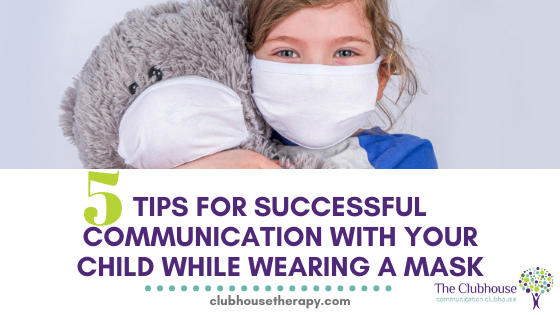We are living in unprecedented times and are all adjusting to a “new normal” as we begin to go out in public with our families again. At this time, the CDC is recommending anyone over the age of 2 wear a mask in public spaces where social distancing is difficult to maintain. This can be a confusing change for children and as an SLP it leads me to wonder the impact this may have on our kids’ ability to communicate successfully.
Masks make it impossible for children to see others’ mouths, which is a huge part of communicating. They can also impact kids’ ability to recognize facial expressions and even distort sounds. Additionally, it can be uncomfortable and awkward for kids to try and talk with a mask. While this is new territory for everyone to navigate, here is some guidance for effectively communicating with your child while wearing masks!
1. Environment Counts
Try to eliminate background noise as much as possible. If your child can’t understand what you’re saying with your mask on, utilize the environment and show them by pointing to what you’re talking about. If you are unable to understand what your child is saying, ask them to show you by pointing or walking you over to what they’re talking about.
2. Speak Loud and Clear
Be sure to speak louder and slower with a mask so your child can better hear what you’re saying. Emphasize your sounds and exaggerate your words. Since the visual cue of your mouth/articulators is gone, your child is solely relying on what they hear. When your child is talking, ask them to speak louder so you can better understand.
3. Body Language
Most of our facial expressions disappear with a mask on. This can be confusing for kids. Make sure you’re aware of your body language and try to use it to help your child understand what you’re saying and how you’re feeling. Think about how your eyes can convey meaning too. Time to try out “smiling with your eyes”!
4. Recast/Model
A mask can pose an extra challenge for kids with speech sound disorders. If your child is talking and produces speech errors, try to recast and model the correct pronunciation. For example, if your child says, “Look a pider”, say “oh yes! You see a sssspider!”. This will provide a good model and encourage them to keep talking even with a strange mask on their face.
5. Be Social
Even in the age of social distancing, it’s still important for children to be social! When out in public, encourage your child to wave to others and appropriately greet people with their masks on. Engage in conversation from a safe distance so your child can keep up with their conversation skills.
Hopefully these tips can help reduce frustration for you and your child while trying to communicate with masks on in public. Remember to support your child’s speech/language when at home where no mask is needed. Hope everyone stays healthy and safe!
By Melanie Krupowicz, M.S., CCC-SLP

